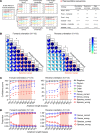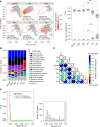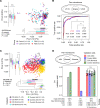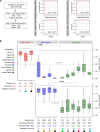The pan-microbiome profiling system Taxa4Meta identifies clinical dysbiotic features and classifies diarrheal disease
- PMID: 37962956
- PMCID: PMC10786686
- DOI: 10.1172/JCI170859
The pan-microbiome profiling system Taxa4Meta identifies clinical dysbiotic features and classifies diarrheal disease
Abstract
Targeted metagenomic sequencing is an emerging strategy to survey disease-specific microbiome biomarkers for clinical diagnosis and prognosis. However, this approach often yields inconsistent or conflicting results owing to inadequate study power and sequencing bias. We introduce Taxa4Meta, a bioinformatics pipeline explicitly designed to compensate for technical and demographic bias. We designed and validated Taxa4Meta for accurate taxonomic profiling of 16S rRNA amplicon data acquired from different sequencing strategies. Taxa4Meta offers significant potential in identifying clinical dysbiotic features that can reliably predict human disease, validated comprehensively via reanalysis of individual patient 16S data sets. We leveraged the power of Taxa4Meta's pan-microbiome profiling to generate 16S-based classifiers that exhibited excellent utility for stratification of diarrheal patients with Clostridioides difficile infection, irritable bowel syndrome, or inflammatory bowel diseases, which represent common misdiagnoses and pose significant challenges for clinical management. We believe that Taxa4Meta represents a new "best practices" approach to individual microbiome surveys that can be used to define gut dysbiosis at a population-scale level.
Keywords: Bacterial infections; Gastroenterology; Infectious disease.
Conflict of interest statement
Figures





Similar articles
-
Characteristic dysbiosis of gut microbiota of Chinese patients with diarrhea-predominant irritable bowel syndrome by an insight into the pan-microbiome.Chin Med J (Engl). 2019 Apr 20;132(8):889-904. doi: 10.1097/CM9.0000000000000192. Chin Med J (Engl). 2019. PMID: 30958430 Free PMC article.
-
Gut Bacterial Dysbiosis in Irritable Bowel Syndrome: a Case-Control Study and a Cross-Cohort Analysis Using Publicly Available Data Sets.Microbiol Spectr. 2023 Feb 14;11(1):e0212522. doi: 10.1128/spectrum.02125-22. Epub 2023 Jan 18. Microbiol Spectr. 2023. PMID: 36652592 Free PMC article.
-
Characterization of the human gut microbiome during travelers' diarrhea.Gut Microbes. 2015;6(2):110-9. doi: 10.1080/19490976.2015.1019693. Gut Microbes. 2015. PMID: 25695334 Free PMC article.
-
Restoration of dysbiotic human gut microbiome for homeostasis.Life Sci. 2021 Aug 1;278:119622. doi: 10.1016/j.lfs.2021.119622. Epub 2021 May 17. Life Sci. 2021. PMID: 34015282 Review.
-
[The human gut microbiota].Ugeskr Laeger. 2017 Dec 4;179(49):V05170378. Ugeskr Laeger. 2017. PMID: 29212595 Review. Danish.
Cited by
-
Leveraging human microbiomes for disease prediction and treatment.Trends Pharmacol Sci. 2025 Jan;46(1):32-44. doi: 10.1016/j.tips.2024.11.007. Epub 2024 Dec 27. Trends Pharmacol Sci. 2025. PMID: 39732609
-
A population-scale analysis of 36 gut microbiome studies reveals universal species signatures for common diseases.NPJ Biofilms Microbiomes. 2024 Oct 1;10(1):96. doi: 10.1038/s41522-024-00567-9. NPJ Biofilms Microbiomes. 2024. PMID: 39349486 Free PMC article.
-
Impact of gut health and microbiome on autism spectrum disorder.Transl Pediatr. 2024 Jun 30;13(6):1012-1016. doi: 10.21037/tp-24-84. Epub 2024 Jun 25. Transl Pediatr. 2024. PMID: 38984018 Free PMC article. No abstract available.

